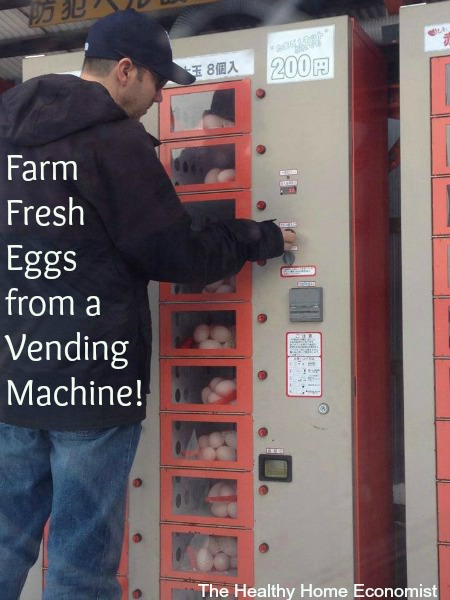
Without a doubt, one of the most challenging aspects of eating local and buying as much as possible from small businesses and farms within your community is the logistical nightmare of coordinating pickups.
I was emailing back and forth with a doctor just last week about how to get a local farmer’s fresh, completely pastured buffalo milk to market to help the business get off the ground.
The truth is, it’s just not easy to obtain these healthy, local, nutrient dense foods and the inconvenience of having to be at a certain place at a certain time or potentially driving an hour or two round trip one or more times a week to pick up your food is just too daunting for most people today living a modern, stressed out lifestyle.
It’s so much easier to just go to the supermarket and blithely load up your shopping cart with colorful boxes and attractive packages and stay in denial about all the GMOs, chemicals and additives you are consuming and feeding your children on a regular basis.
It doesn’t have to be this way. Eating local and fresh could be much more convenient when technology is harnessed to help out.
I’ve written before about raw milk vending machines popping up all over Europe. The one minute video below shows how one works in France.
Would these machines ever be allowed anywhere in the United States? Probably not because the CDC insists that raw milk is “dangerous”.
Really?
If raw milk was as dangerous as the CDC and conventional medical authorities in the USA claim, wouldn’t these machines that are popping up all over Europe be causing some serious food borne illness outbreaks by now?
The same confounding mindset exists for farm fresh eggs where astoundingly, caged battery produced eggs are considered “safer” by the USDA than eggs from chickens living outside because birds that are kept indoors won’t have any contact with (gasp!) wild birds.
The picture at the top was sent to me my Lauren S., which shows her brother-in-law buying farm fresh eggs out of a vending machine in Japan. He is living there with his family as part of a stint with the Air Force. Her sister said that the local farmers deliver eggs fresh daily to these machines and the surrounding community has the convenience of obtaining fresh eggs anytime of the day or night.
Wouldn’t you love to see this at a local convenience store in America right next to the soda machine? If someone has the right to purchase and fill their gut full of that GMO sugar junk, shouldn’t I be able to opt out and conveniently purchase farm fresh eggs from a machine too?
Keeping it inconvenient is all part of Big Ag’s plan via the ever tightening noose around the neck of sustainable farming in North America. Case in point: the King Amendment currently being debated at the Federal level as part of the 1 trillion dollar Farm Bill which would take the situation from bad to worse as it would prevent states from enforcing their own laws regarding the production of “agricultural products”. State laws against cruel gestation crates, battery cages for hens, and even bans on horse slaughter and eating dogs and cats for food could be in jeopardy. Not only would existing laws be in danger if the King Amendment passes, but it would also prevent states from passing new laws to protect farm animals which in turn protects the food supply from nutrient erosion (source).
What these types of measures do is gradually hand over complete control of the food supply to Big Food corporations and the Biotech industry – bit by bit served up on a silver platter by the USDA and FDA which overwhelmingly favor industrialized, sterilized, nutritionless food production to small scale, locally produced, nutrient rich, sustainable whole foods.
As long as bureaucrats who push paper and have never lifted a pitchfork are calling the shots regarding the regulation and distribution of our food supply, harnessing technology as is being done in other parts of the world to make nutrient dense, local food conveniently available to all will be impossible.
Sarah, The Healthy Home Economist








We do have a problem with Egg labeling as it’s very miss leading.
The carton of eggs is tricky to read.
Such as cage free..That means there not in a cage , but raised in large barns with 1000’s of birds. Only a one hole that a couple birds might get out , but no grass, so they come back in.
Vegetarian eggs.Do not buy. As it Means the birds are not eating Grass & bugs. (indoor chickens)
Free Range, can also mean NOT Organic.
In Organic chicken food, the second ingredient is Soy..Soy is a hormone, and fattens up all animals, and us.
We should be buying, Organic, free range, Pastured, No Gmo, No soy , No Anti-Biotics, No Hormone, Eggs.
I’m getting my Chicken coop ready for the spring to hold about 4 chickens..Which will be enough for my family.
I personally feel, If I have my own chickens I will know exactly what there eating.
I want to mention, before buying Organic meat.
Make sure the meat also say’s, “Pastured”, Grass feed. If it doesn’t, Pass on buying it…
If it say’s Organic, but not Pastured, it means it was raised in a barn or coral, and also eating Soy grains, NOT eating Grass, bugs, etc.
Some producers of foods are tricky, by also saying Natural, which does not mean a darn thing.
I just want to know where I can get that buffalo milk from!
Eating locally is not necessary more healthy. People use sprays and dusts. The food is fresher. To be organic, a person needs to grow the food them self.